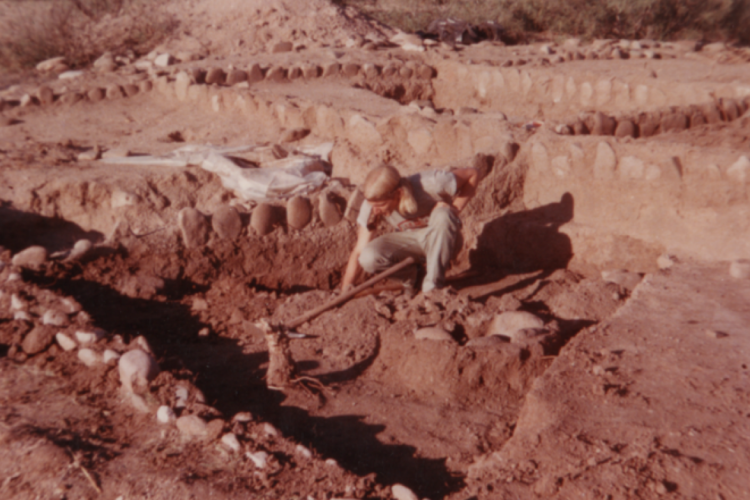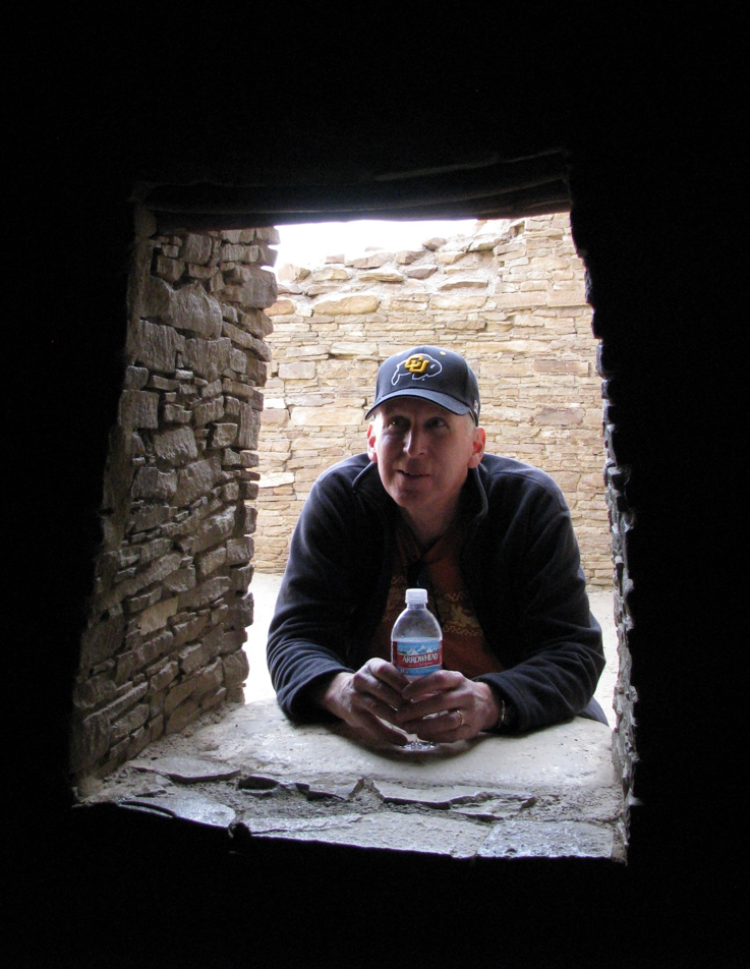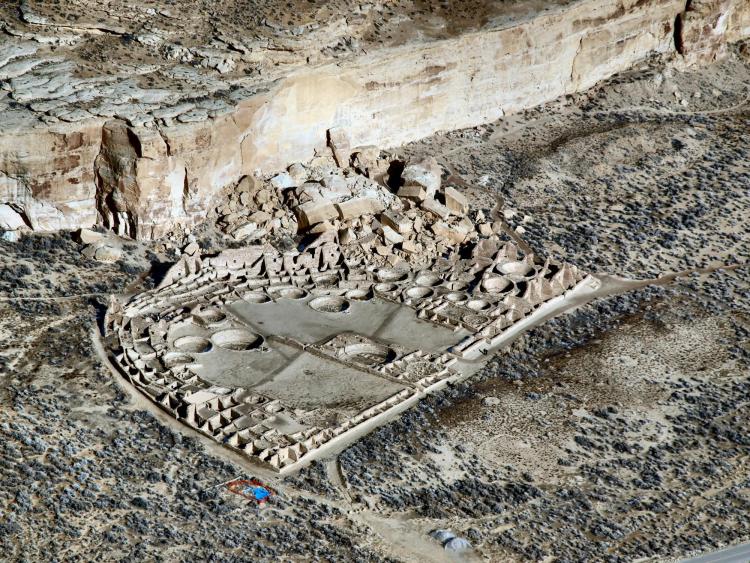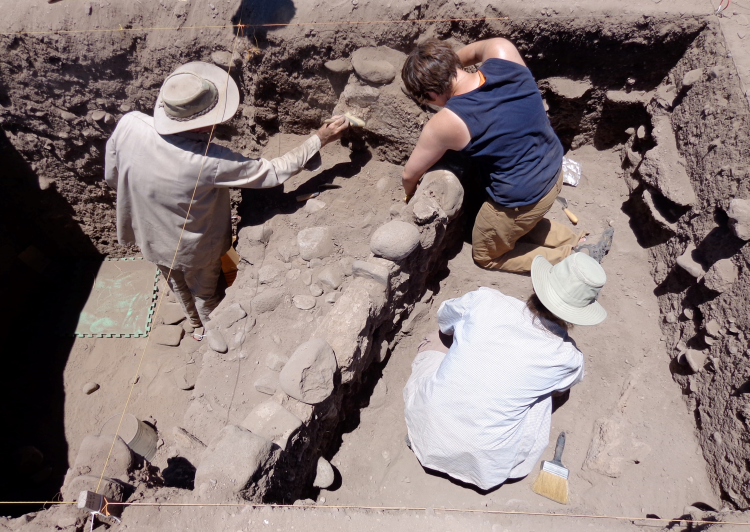A modern look at Chaco Canyon’s ancient past
Banner image: Stephen Lekson (with tripod) and colleagues excavate the great house at Chimney Rock in southern Colorado. (Credit: CU Boulder)


Top: Stephen Lekson excavating an archaeological site in southwestern New Mexico in 1972; bottom: A more recent image of Lekson at Pueblo Bonito in Chaco Culture National Historic Park. (Credits: Stephen Lekson)
Some of Stephen Lekson’s fondest memories from his 45-plus years as an archaeologist are of mornings at Chimney Rock.
This site in southern Colorado was a satellite community for a society called the Chaco Canyon culture, which thrived in the Four Corners region from about 850 to 1150 A.D.
The town spreads over sandstone cliffs that climb nearly 1,000 feet above a valley. And at the top of what Lekson called a “knife edge ridge” is a great house, a massive living space that overlooks the smaller dwellings below.
To get to that building, “you’d drive up out of the clouds, and the fog would burn off, and you’d see mountains all around,” said Lekson of the CU Boulder Museum of Natural History and Department of Anthropology. “It’s a beautiful setting.”
But for Lekson, who recently retired, that beautiful setting also says something about the ancestral Pueblo peoples who lived there. He contends that the Chaco Canyon culture was a stratified civilization, ruled by elites or royals who resided in great houses and towered over castes of commoners—literally, in the case of Chimney Rock.
It’s an argument that goes against what generations of archaeologists have believed about the Southwest: that the people who populated this region before contact with Europeans lived only in small, agrarian and egalitarian societies. It’s also the central theme of the scientist’s new book, A Study of Southwestern Archaeology.
“In the Southwest, we’ve had this glass ceiling that got set over the field more than 100 years ago,” Lekson said. “And for some reason or another we just can’t get out from underneath it.”
Chocolate and parrots
That glass ceiling, Lekson explained, begins with academic baggage—in particular, the assumptions that white archaeologists made about the Southwest in the early 20th Century.
Public intellectuals like Ruth Benedict and John Collier, reeling from the violence of World War I, created an image of the Southwest that was filled with “Zen gardeners,” Lekson said—peaceful people who lived in harmony with their environment. It had little to do with the lives of actual Pueblo peoples, modern or ancestral.
“In that interwar period, there was a lot of change,” Lekson said. “I think that image of Pueblos appealed to Americans: They’re permanent, constant and peaceful.”
In his new book, which was released in late 2018, he makes the case that such a stereotype doesn’t fit for huge chunks of the historic Southwest, including Chaco Canyon.
That civilization, he said, may have encompassed as many as 100,000 people at its height, with a capital city in what is now Chaco Culture National Historic Park in New Mexico. And they probably weren’t all equal.
Take a great house about 85 miles south of Chimney Rock called Pueblo Bonito: The rulers who lived in this building—which was four stories tall and contained an estimated 650 rooms—drank cacao and kept macaws imported from Mexico. They also buried select members of their dead in indoor crypts lavished with thousands of turquoise beads. That’s a big contrast with commoners who lived in much smaller homes and buried their own dead in communal cemeteries.


Top: An aerial view of Pueblo Bonito, which spreads over nearly two acres; bottom: Lekson and his colleagues excavate Woodrow Ruin in New Mexico. (Credits: Robert Adams; Stephen Lekson)
“If you picked up Chaco and dropped it anywhere else in the world, archaeologists wouldn’t have any problem with it,” Lekson said. “In the Southwest, we’ve turned it into a pilgrimage center, anything but a capital city, which is clearly what it was.”
Scott Ortman, an assistant professor in anthropology at CU Boulder, has also studied the ancient Southwest. He agrees that Chaco Canyon looks like nothing else for hundreds of miles.
“There are all these ways in which the legacy of early anthropology is still with the field,” he said. “I think Steve’s book is the clearest and best deconstruction of that.”
Moving forward
It is also Lekson’s last book as an archaeologist—probably. With that in mind, he doesn’t want to come off as a gadfly or a malcontent. Instead, he’s trying to answer a question that many young researchers have asked him: what now?
Lekson’s biggest piece of advice is that members of his field need to start thinking less like cultural anthropologists and more like historians. In practice, that means taking a deeper look at archaeological evidence and paying attention when that data doesn’t fit the academic stereotype of a Pueblo.
“We treat these societies as following a straight line to when some white guy shows up in 1920s and writes down an anthropological account,” Lekson said. “But a historian would say that in any society, there are ups and downs and dead ends.”
In other words, Lekson hopes that Southwestern archaeologists will begin to see the region for what it is: complex, dynamic and human.
“That’s all I’m trying to do in this book—to draw out some things that will help to move the field forward,” he said.


